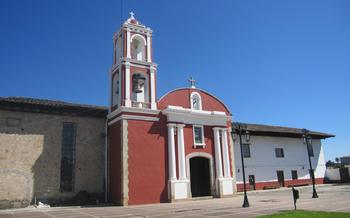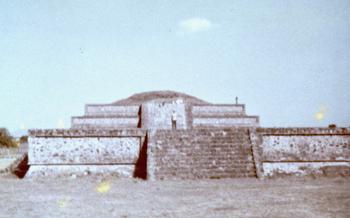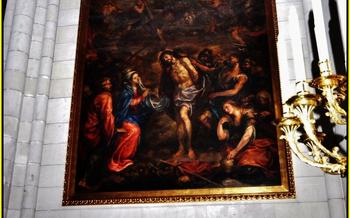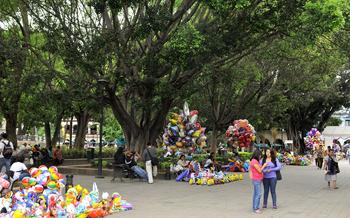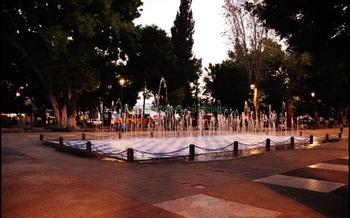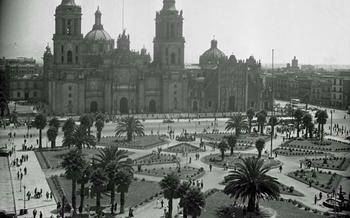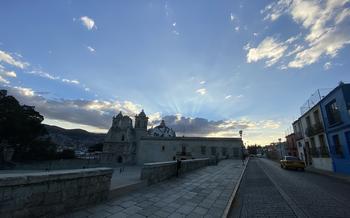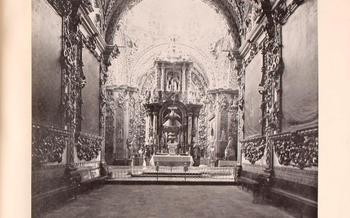
Plaza de la Concordia
- Plaza de la Concordia: A Historical Gem in Puebla
- Strolling the Majestic Corridors
- Exploring the Palacio Municipal
- Admire the Cathedral of Puebla
- Discover the Museo Amparo
- Step into the Chapel of the Rosary
- History and Significance of the Chapel
- Architectural Features and Design
- Cultural and Religious Importance
- Delight in the Culinary Delights
- Witness the Serdán Brothers' Legacy
- Take a Break in the Jardín del Carmen
- Experience the Talavera Tiles
- Vibrant Celebrations and Festivals
- Theatrical Performances at the Teatro Principal
- Capture the Essence of Puebla
- Insider Tip: Hidden Gems Around the Plaza
Plaza de la Concordia: A Historical Gem in Puebla
In the heart of Puebla, a city steeped in history and vibrant culture, lies the Plaza de la Concordia, a magnificent square that has witnessed the unfolding of centuries. Once known as the Zócalo, this plaza has served as the city's central gathering place since its founding in 153It is a testament to Puebla's rich architectural heritage, showcasing a harmonious blend of colonial and contemporary styles.
The plaza's historical significance is undeniable. It was here that the city's founders, led by Fray Toribio de Benavente, laid the first stone, marking the birth of Puebla de los Ángeles. Over the years, the plaza has been the stage for countless events that shaped the city's destiny, from grand celebrations to political rallies.
Architecturally, the Plaza de la Concordia is a masterpiece of urban design. Its symmetrical layout, with its central fountain surrounded by elegant buildings, creates a sense of harmony and grandeur. The surrounding buildings, with their intricate facades, arched doorways, and colorful tiles, reflect the city's unique architectural style.
Culturally, the Plaza de la Concordia is a vibrant hub of activity. It is a place where locals and visitors alike gather to socialize, celebrate, and experience the essence of Puebla. Street performers entertain the crowds with music, dance, and acrobatics, while vendors offer local delicacies and souvenirs.
Strolling the Majestic Corridors
The Plaza de la Concordia showcases a harmonious layout, featuring manicured gardens, intricate fountains, and elegant promenades that invite visitors to stroll and soak in the ambiance. The surrounding buildings boast a blend of architectural styles, from colonial to neoclassical, creating a visually captivating scene. Among the notable structures gracing the plaza are the Palacio Municipal, the Cathedral of Puebla, and the Museo Amparo.
As you wander through the plaza, keep an eye out for the talented street performers who showcase their skills, adding a touch of vibrancy to the atmosphere. Local vendors line the perimeter, offering a variety of souvenirs, handicrafts, and traditional snacks, providing an opportunity to support the local economy and take home a piece of Puebla's charm.
Exploring the Palacio Municipal
In the heart of the Plaza de la Concordia, the Palacio Municipal stands as a testament to Puebla's rich history and architectural prowess. Built in the 16th century, this grand edifice has served as the seat of local government for centuries. Its majestic facade, adorned with intricate carvings and arches, reflects the fusion of Spanish Renaissance and Baroque styles that define Puebla's architectural identity.
The Palacio Municipal's interior is equally impressive, with grand staircases, ornate chandeliers, and a stunning central courtyard. Visitors can admire the intricate murals adorning the walls, depicting scenes from Puebla's history and culture. The building also houses a museum dedicated to the city's past, showcasing artifacts, documents, and interactive exhibits that bring Puebla's story to life.
Currently, the Palacio Municipal remains the center of Puebla's civic life, hosting official ceremonies, meetings, and events. While it serves as a functional government building, it also welcomes visitors who wish to explore its historical significance and architectural beauty. Guided tours are available, allowing visitors to delve deeper into the stories and secrets behind this iconic landmark.
Admire the Cathedral of Puebla
The Cathedral of Puebla, officially known as the Metropolitan Cathedral of the Assumption of the Blessed Virgin Mary, stands as a testament to the city's rich religious heritage. Its construction began in 1575 and spanned over two centuries, resulting in a magnificent blend of architectural styles, from Gothic to Baroque. The cathedral's towering spires dominate the skyline, inviting visitors to explore its grandeur.
Architectural Highlights and Design:
The Cathedral of Puebla boasts an impressive façade adorned with intricate carvings, sculptures, and reliefs depicting biblical scenes. The main portal features a stunning altarpiece dedicated to the Assumption of the Virgin Mary, while the interior showcases a series of side chapels, each with its unique design and artwork. The cathedral's vaulted ceilings, supported by massive pillars, create a sense of awe and reverence.
Cultural and Religious Importance:
As the seat of the Archdiocese of Puebla, the cathedral holds immense religious significance for the city's Catholic population. It serves as a venue for important religious ceremonies, including masses, processions, and festivals. The cathedral also plays a crucial role in preserving and promoting the cultural heritage of Puebla, hosting concerts, exhibitions, and other cultural events throughout the year.
Discover the Museo Amparo
Explore a Treasure Trove of Mexican Art and History
Nestled in the heart of the Plaza de la Concordia, the Museo Amparo stands as a testament to the rich cultural heritage of Puebla. Founded in 1991, this world-class museum houses an impressive collection of pre-Hispanic, colonial, and modern Mexican art, offering visitors a journey through centuries of artistic expression.
The museum's collection boasts over 3,500 artifacts, spanning from ancient Mesoamerican sculptures to contemporary masterpieces. Visitors can marvel at the intricate details of pre-Hispanic ceramics, admire the vibrant colors of colonial paintings, and appreciate the innovative works of modern Mexican artists.
One of the highlights of the museum is the Sala de Arte Prehispánico, which showcases a remarkable collection of pre-Columbian artifacts from various regions of Mexico. Visitors can admire the exquisite craftsmanship of Olmec heads, the enigmatic Zapotec funerary urns, and the intricate gold jewelry of the Mixtec civilization.
The museum also features an extensive collection of colonial art, including paintings, sculptures, and furniture. Visitors can explore the Sala de Arte Colonial, which displays works by renowned artists such as Miguel Cabrera, José Juárez, and Juan Correa. The collection offers a glimpse into the religious and cultural life of colonial Puebla.
In addition to its permanent collection, the Museo Amparo frequently hosts temporary exhibitions, showcasing the works of contemporary Mexican and international artists. These exhibitions provide a platform for emerging artists and allow visitors to engage with the latest trends in Mexican art.
The Museo Amparo also offers educational programs and workshops, providing opportunities for visitors to learn more about Mexican art and culture. Whether you are an art enthusiast, a history buff, or simply curious to discover the cultural treasures of Puebla, the Museo Amparo is a must-visit destination.
Step into the Chapel of the Rosary
Nestled within the heart of the Plaza de la Concordia, the Chapel of the Rosary stands as a testament to Puebla's rich religious and architectural heritage. Founded in the 16th century by the Dominican order, this sacred space has undergone several transformations over the centuries, culminating in its current breathtaking Baroque splendor.
History and Significance of the Chapel
The Chapel of the Rosary holds a significant place in Puebla's history. It was initially constructed as a small chapel dedicated to Our Lady of the Rosary. However, as the city grew and the Dominican order gained prominence, the chapel underwent several expansions and renovations. The most significant transformation occurred in the 18th century when renowned architect and sculptor Manuel Tolsá was commissioned to redesign the chapel. Tolsá's vision transformed the once-humble structure into the Baroque masterpiece it is today.
Architectural Features and Design
The Chapel of the Rosary is a prime example of Baroque architecture, characterized by its intricate ornamentation, dramatic lighting, and illusionistic ceiling paintings. The facade is adorned with elaborate carvings depicting angels, saints, and scenes from the life of the Virgin Mary. Inside, the chapel's walls are covered in intricate tilework, gilded altars, and life-size sculptures. The most striking feature is the ceiling, which features a series of vibrant frescoes depicting scenes from the life of Christ and the Virgin Mary. These stunning murals, attributed to Miguel Cabrera, create an awe-inspiring and immersive experience for visitors.
Cultural and Religious Importance
The Chapel of the Rosary holds immense cultural and religious significance for the people of Puebla. It is considered one of the city's most important religious sites and is a popular destination for pilgrims and tourists alike. Throughout the year, the chapel hosts numerous religious celebrations, including masses, processions, and festivals, which draw thousands of devotees. Its stunning architecture and rich history make it a symbol of Puebla's cultural heritage and a must-visit attraction for anyone interested in exploring the city's religious traditions.
Delight in the Culinary Delights
Puebla's culinary scene is a vibrant tapestry of flavors, colors, and aromas, and the Plaza de la Concordia is at its epicenter. From traditional Mexican dishes to international cuisine, there's something to satisfy every palate.
For a taste of authentic Mexican cuisine, try the chiles en nogada, a classic Poblano dish consisting of poblano peppers stuffed with picadillo, topped with a walnut sauce, and garnished with pomegranate seeds and parsley. Another must-try is mole poblano, a complex and flavorful sauce made with over 20 ingredients, including chocolate, chili peppers, and spices, served with chicken or turkey.
Tacos are a ubiquitous street food in Mexico, and Puebla is no exception. From traditional al pastor (spit-roasted pork) to unique creations like tacos árabes (shawarma-inspired tacos), there are endless options to choose from.
No visit to Puebla is complete without sampling the Cemitas, a local sandwich made with a sesame seed bun, filled with various meats, cheeses, and toppings.
When it comes to sweet treats, chongos zamoranos are a must-try. These are candied milk curds, often served with fruit or ice cream. Another local delicacy is tortitas de Santa Clara, a type of sweet pastry filled with fruit preserves.
For a unique dining experience, head to the Mercado de El Carmen, a bustling market located just off the plaza. Here, you'll find a variety of food stalls selling everything from traditional Mexican dishes to fresh produce and artisanal goods.
Witness the Serdán Brothers' Legacy
In the heart of Puebla, the legacy of the Serdán Brothers, Aquiles, Máximo, and Carmen, stands as a testament to their unwavering courage and patriotism. Their story is intricately intertwined with the events leading to the Mexican Revolution, making the Plaza de la Concordia a site of historical significance.
The Casa de los Hermanos Serdán Museum, located within the plaza, offers a glimpse into their lives and the events that unfolded within these walls. The museum showcases personal belongings, photographs, and artifacts that narrate the brothers' revolutionary activities and their fight for social justice.
The Serdán Brothers were instrumental in organizing the anti-reelectionist movement against President Porfirio Díaz. Their home, which is now the museum, served as a meeting point for revolutionaries and a center for planning the uprising. It was here that the first shots of the Mexican Revolution were fired on November 18, 19
Their heroic actions and sacrifice left an indelible mark on Mexican history, inspiring generations to stand up for their rights and fight for a better future. The Plaza de la Concordia, with the Serdán Brothers' legacy deeply embedded within its walls, serves as a constant reminder of their unwavering spirit and the power of collective action.
Take a Break in the Jardín del Carmen
Nestled just a short stroll from the Plaza de la Concordia, the Jardín del Carmen offers a tranquil oasis amidst the vibrant city. This charming garden, dating back to the 16th century, was once part of the Carmelite Convent of Santa Teresa. Today, it serves as a peaceful retreat for locals and visitors alike.
As you step into the garden, you are greeted by a verdant expanse of lush greenery, punctuated by colorful flowerbeds and towering trees. The air is filled with the sweet scent of jasmine and the cheerful chirping of birds. Take a leisurely stroll along the cobblestone paths, admiring the meticulously manicured lawns and the serene fountains.
At the heart of the garden lies the Templo del Carmen, a beautiful church known for its intricate Baroque architecture. The church's façade is adorned with ornate carvings and sculptures, while its interior boasts a stunning collection of religious artwork. Take a moment to explore the church and admire its many treasures.
After your visit to the church, relax on one of the benches beneath the shade of a tree and soak in the tranquil atmosphere. The garden is a popular spot for locals to gather, chat, and enjoy each other's company. You may even catch a glimpse of a couple strolling hand-in-hand or a group of friends sharing a picnic.
The Jardín del Carmen is a true hidden gem, offering a respite from the hustle and bustle of the city. Whether you are looking to take a break, enjoy a picnic, or simply appreciate the beauty of nature, this charming garden is the perfect place to do so.
Experience the Talavera Tiles
Puebla's Talavera tiles, with their vibrant hues and intricate designs, are a symbol of the city's rich cultural heritage and craftsmanship. These tiles, crafted from a unique blend of clay and glaze, have been an integral part of Puebla's architecture and decorative arts for centuries.
Visit the Talavera workshops and factories to witness the meticulous process of creating these beautiful tiles. Learn about the history and techniques involved in their production, from the selection of clays to the intricate hand-painting and firing process.
Browse the numerous shops and galleries in the city center to find a wide array of Talavera products, from traditional tiles to decorative plates, vases, and jewelry. These exquisite pieces make for unique souvenirs and gifts that capture the essence of Puebla's artistic traditions.
Immerse yourself in the beauty of Talavera tiles by visiting the city's many Talavera-clad buildings, such as the Casa del Alfeñique, the Templo de Santo Domingo, and the Museo Amparo. Admire the intricate designs and vibrant colors that adorn these historic structures, showcasing the enduring legacy of Puebla's Talavera tile-making tradition.
Vibrant Celebrations and Festivals
The Plaza de la Concordia comes alive during various traditional festivals and celebrations that showcase Puebla's rich cultural heritage. One of the most notable events is the International Baroque Festival, held annually in October, which features concerts, exhibitions, and performances inspired by the city's Baroque architecture and artistic traditions.
Another popular celebration is the Festival de la China Poblana, held in April, which pays homage to the iconic figure of the China Poblana, a woman of Chinese descent who became a symbol of cultural fusion in Puebla. The festival features parades, traditional dances, and colorful costumes, creating a vibrant atmosphere in the plaza.
During the Day of the Dead celebrations in November, the plaza transforms into a festive hub adorned with colorful altars, marigolds, and papel picado. Families gather to honor their deceased loved ones, creating a poignant and meaningful atmosphere.
To fully experience the essence of Puebla, visitors should aim to coincide their trip with one of these vibrant celebrations. The plaza becomes a stage for cultural expression, where traditions, music, dance, and community spirit intertwine, offering a unique and unforgettable experience.
Theatrical Performances at the Teatro Principal
Nestled within the heart of the Plaza de la Concordia, the Teatro Principal stands as a testament to Puebla's rich cultural heritage and its enduring passion for the performing arts. This historic theater, inaugurated in 1855, has played a pivotal role in shaping the city's cultural landscape and continues to captivate audiences with its enchanting performances.
The Teatro Principal's ornate facade, adorned with intricate carvings and sculptures, hints at the theatrical wonders that await within. Its elegant auditorium, with its plush red seats and intricate balconies, exudes an aura of grandeur and timeless elegance. Over the years, this renowned stage has hosted a dazzling array of performances, from classical plays and operas to contemporary dance productions and musical concerts.
Attending a show at the Teatro Principal is an experience that transports visitors back in time, allowing them to immerse themselves in the magic and artistry of live theater. The theater's acoustics are impeccable, ensuring that every note and word rings clear and true, while the intimate setting creates a palpable connection between performers and audience.
Whether you're a seasoned theater-goer or a first-time visitor, the Teatro Principal offers an unforgettable experience. Check the theater's website or local listings for upcoming performances and immerse yourself in the vibrant world of theater in this historic and enchanting venue.
Capture the Essence of Puebla
The Plaza de la Concordia is not just a historical and cultural hub but also a visual masterpiece that beckons photographers and art enthusiasts. With its stunning architecture, vibrant colors, and lively atmosphere, the plaza offers countless opportunities to capture the essence of Puebla.
The towering cathedral, with its intricate facade and majestic dome, is a must-shoot for any visitor. Capture the grandeur of the building from different angles, experimenting with wide-angle lenses to encompass its full scale or close-ups to highlight its intricate details.
Don't miss the opportunity to photograph the colorful Talavera tiles that adorn many buildings around the plaza. These vibrant tiles, with their intricate patterns and rich hues, are a symbol of Puebla's artistic heritage. Look for unique angles and compositions that showcase the tiles' beauty and craftsmanship.
People-watching is another great way to capture the essence of the plaza. The lively atmosphere, with street performers, vendors, and locals going about their daily lives, provides ample opportunities for candid shots. Experiment with different shutter speeds to capture the movement and energy of the crowd.
For a unique perspective, head to the rooftop terraces of some of the hotels or restaurants around the plaza. From these vantage points, you can capture panoramic shots that encompass the entire square, including the cathedral, the Palacio Municipal, and the surrounding cityscape.
Remember to play with light and shadows to add depth and drama to your photographs. The golden hour, just before sunset, is an ideal time to capture the warm glow of the setting sun illuminating the plaza's buildings and streets.
Whether you're a professional photographer or simply an enthusiast with a smartphone, the Plaza de la Concordia offers countless opportunities to capture the beauty and spirit of Puebla. Embrace your creativity and let the city's rich history, vibrant culture, and stunning architecture inspire your photographic journey.
Insider Tip: Hidden Gems Around the Plaza
Beyond the main attractions, the Plaza de la Concordia conceals a plethora of hidden gems waiting to be discovered. Venture down the charming side streets to uncover secluded plazas, quaint cafes, and unique shops. The Plaza de San José, located just a short walk away, boasts a beautiful 18th-century fountain and offers a tranquil oasis amidst the bustling city.
For a taste of local flavor, head to the Mercado La Acocota, a traditional market where you can browse local produce, handicrafts, and delicious street food. Don't miss the chance to sample the famous cemitas poblanas, a mouthwatering sandwich filled with various meats, cheeses, and vegetables.
Art enthusiasts will appreciate the Museo del Alfeñique, dedicated to the intricate art of sugar crafting. Marvel at the delicate figurines, skulls, and other creations made entirely from sugar, a testament to Puebla's rich culinary and artistic traditions.
As you explore the hidden corners around the Plaza de la Concordia, embrace the opportunity to connect with the locals and learn about their customs and traditions. Whether it's chatting with a friendly shopkeeper, savoring a cup of coffee at a local cafe, or joining a traditional dance class, there are endless ways to immerse yourself in the vibrant culture of Puebla.
